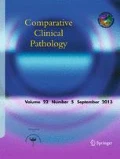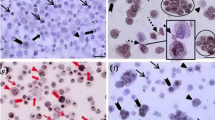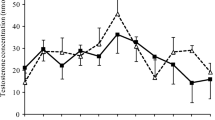Abstract
Spermatogenesis is a complex developmental process that originates from spermatogonia stem cell. This process consists of sequential, highly organized steps of cell proliferation and differentiation resulting in the generation of functional spermatozoa. Many growth factors, hormones, and cell interactions of germ cells with Sertoli cells regulate these processes, and the failure of any of the processes can lead to male infertility The aim of the present study was to determine the effects of equine chorionic gonadotropin on spermatogonial stem cell colony formation and differentiation after in vitro co-culture with Sertoli cells. In this experimental study, Sertoli and spermatogonial stem cells were isolated from 3- to 5-month-old calves. Co-cultured Sertoli and spermatogonial stem cells were treated with equine chorionic gonadotropin in treatment groups before colony assay. The present study showed that equine chorionic gonadotropin increase colony number and decrease colony diameter. Equine chorionic gonadotropin can induce proliferative pathway and inhibit differentiation process in spermatogonia stem cell co-culture with Sertoli cells.






Similar content being viewed by others
References
Alomar M, Zarkawi M, Alzoabi MA (2018) Analysis of Awassi sperm motility in two media at different evels of temperature, pH and osmolality. Iran J App Anim Sci 8:431–438
Anjamrooz SH, Movahedin M, Tiraihi T, Mowla SJ (2006) In vitro effects of epidermal growth factor, follicle stimulating hormone and testosterone on mouse spermatogonial cell colony formation. Reprod Fertil Dev 18:709–720
Anway MD, Folmer J, Wright WW, Zirkin BR (2003) Isolation of sertoli cells from adult rat testes: an approach to ex vivo studies of sertoli cell function. Biol Reprod 68:996–1002
Baarends W, Grootegoed J (1999) Molecular biology of male gametogenesis. Molecular biology in reproductive medicine New York, USA: parthenon publishing group 271-295
De Franca LR, Silva VA, Chiarini-Garcia H, Garcia SK, Debeljuk L (2000) Cell proliferation and hormonal changes during postnatal development of the testis in the pig. Biol Reprod 63:1629–1636
De Franca LR, Avelar GF, Almeida FL (2005) Spermatogenesis and sperm transit through the epididymis in mammals with emphasis on pigs. Theriogenol 63:300–318
Dym M, Cavicchia JC (1997) Further observations on the blood-testis barrier in monkeys. Biol Reprod 17:390–403
Enders GC, May JJ II (1994) Developmentally regulated expression of a mouse germ cell nuclear antigen examined from embryonic day 11 to adult in male and female mice. Dev Biol 163:331–340
Izadyar F, Matthijs-Rijsenbilt JJ, Ouden KD, Creemers LB, Woelders H, de Rooij DG (2002) Development of a cryopreservation protocol for type a spermatogonia. J Androl 23:537–545
Kojima Y, Kominami K, Dohmae K, Nonomura N, Miki T, Okuyama A (1997) Cessation of spermatogenesis in juvenile spermatogonial depletion (jsd/jsd) mice. Int J Urol 4:500–507
Kubota H, Avarbock MR, Brinster RL (2004) Growth factors essential for self-renewal and expansion of mouse spermatogonial stem cells. Proc Natl Acad Sci U S A 101:16489–16494
Kumar TR (2005) What have we learned about gonadotropin function from gonadotropin subunit and receptor knockout mice? Reproduction 130:293–302
Lamb DJ, Spotts GS, Shubhada S, Baker KR (1991) Partial characterization of a unique mitogenic activity secreted by rat Sertoli cells. Mol Cell Endocrinol 79:1–12
McLean D, Russell LD, Griswold MD (2002) Biological activity and enrichment of spermatogonial stem cells in vitamin a-deficient and hyperthermia-exposed testes from mice based on colonization following germ cell transplantation. Biol Reprod 66:1374–1379
Meehan T, Schlatt S, O'Bryan MK, de Kretser DM, Loveland KL (2000) Regulation of germ cell and Sertoli cell development by activin, follistatin, and FSH. Dev Biol 220:225–237
Pierce JG, Parsons TF (1981) Glycoprotein hormones: structure and function. Annu Rev Biochem 50:465–495
Tajik P, Sani RN, Moezifar M, Yousefi M, Movahedin M, Qasemi-Panahi B (2014) Effect of follicle-stimulating hormone and testosterone on colony formation of bovine spermatogonial stem cell. Comp Clin Pathol 23:901–906
van Pelt AM, Morena AR, van Dissel-Emiliani FM, Boitani C, Gaemers IC, de Rooij DG (1996) Isolation of the synchronized A spermatogonia from adult vitamin A-deficient rat testes. Biol Reprod 55:439–444
Yoshinaga K, Nishikawa S, Ogawa M, Hayashi S, Kunisada T, Fujimoto T (1991) Role of c-kit in mouse spermatogenesis: identification of spermatogonia as a specific site of c-kit expression and function. Development 113:689–699
Funding
This work was supported by grants to the second author from the Semnan University for DVM thesis.
Author information
Authors and Affiliations
Corresponding author
Ethics declarations
Conflict of interest
The authors declare that they have no conflict of interest.
Ethical approval
The research was conducted in accordance the National Health guidelines, USA, and were approved by the Animal Research Ethical Committee of Semnan University of Faculty of veterinary science.
Additional information
Publisher’s note
Springer Nature remains neutral with regard to jurisdictional claims in published maps and institutional affiliations.
Rights and permissions
About this article
Cite this article
Kashfi, A., Sani, R.N. & Ahmadi-hamedani, M. The beneficial effect of equine chorionic gonadotropin hormone (eCG) on the in vitro co-culture of bovine spermatogonial stem cell with Sertoli cells. Comp Clin Pathol 28, 701–704 (2019). https://doi.org/10.1007/s00580-019-02944-9
Received:
Accepted:
Published:
Issue Date:
DOI: https://doi.org/10.1007/s00580-019-02944-9




